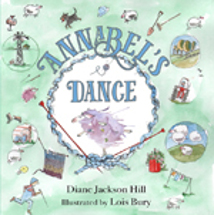Annabel's Dance by Diane Jackson Hill

Ill. by Lois Bury. Wombat Books, 2016. ISBN 9781925139358
Picture book. High in the mountains lived a mob of sheep - ordinary
sheep with wool the colour of whipped cream growing in neat tight
crinkles. With them lived Annabel who was the colour of a mud puddle
and whose wool was straight and spiky. She couldn't just stand and
nibble grass all day - her legs went every which way, she flipped
head over heels, she was always wriggling and jiggling. She was
picky with her food because the grass prickled her tongue; she hid
at shearing time because the loud noises hurt her ears. No matter
how hard she tried, Annabel just didn't fit into the mob and they
shuffled her to the outside.
;"Hazy mazy, oops a daisy, wriggle your ears but don't go crazy,"
she'd tell herself whenever she felt alone or was trying to be
brave.
;Because she hid every time it was shearing time, for six years her
wool grew and grew and grew. But even though it kept her warm and
protected her from bumps, she couldn't see or hear very well.
Annabel is super-sensitive to the world around her and even when
Farmer Shanks tries to help her, she can't cope and makes a dash for
the mountainside.
But he is determined and calls in extra help, gives her headphones
to block out the sound of the shearing machine and even puts a
bucket of strawberry clover nearby so she can imagine herself still
out on the mountainside.
Annabel is like those students we have who are somewhere on the
autism spectrum, whose sensitivities are so heightened they can't
cope with being touched or hearing loud noises, yet all they would
like to do is be part of the mob. To belong. But instead of their
differences being accepted and their needs catered for, they are
shunned and left to themselves until eventually there is a
catastrophe.
This is a humourous but poignant story that can be read on its
surface level as being about an eccentric sheep or it can be
explored more deeply to talk about how we, as people, are all unique
each with our special needs and preferences. But some differences
are not through choice and we need to be more tolerant and more
inclusive, make allowances and reach out to help those who are
struggling or marginalised through no fault of their own - just as
Farmer Shanks did. There are many Annabels in our classrooms as
there are many more children on the spectrum than those who qualify
for special assistance so, as teachers, we need to vary our
practices, help the child develop physical or mental strategies to
cope, and inform the other students so they understand what is
happening. Indeed, under federal legislation, we are obligated to do
so but the crux of this book is that it puts us in Annabel's world
in a way few others stories do and gives some insight into a world
that is too noisy and smelly and busy for some.
Barbara Braxton